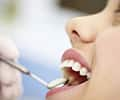What Is Keratinized Tissue In Your Mouth?
Keratinized tissue, also known as keratinized mucosa, refers to the band of tissue surrounding your teeth at the point where they meet the gums. The word "keratinized" is used to describe cells that produce large amounts of a protein called keratin, making them strong and better at forming barriers.
The keratinized tissue in your mouth holds your teeth in place and protects the roots. When healthy, the tissue securely attaches to your teeth, feels firm to the touch, and ranges from pink to brown in color, depending on your skin tone.
How Does Keratinized Tissue Impact Your Dental Implant?
If you need a dental implant, the keratinized tissue also supports the replacement tooth. The amount of keratinized tissue you have might play a critical role in the implant's appearance, implant placement, and ability to keep the implant clean. A study published in The Journal of Indian Prosthodontic Society found it important to assess the tissue's width and thickness before dental implant placement. The study concluded that an adequate amount of keratinized gum tissue is essential for long-term implant success.
Your dental professional might recommend increasing the amount of tissue at the site of the implant. A study published in the Journal of Cosmetic Dentistry found that preserving or reconstructing the band of gum tissue at the site of an implant might improve the prosthetic tooth's appearance and help control plaque buildup around the implant.
Dentists often disagree on the precise amount of tissue required for a dental implant, as noted by both studies. Still, the presence of keratinized tissue is necessary for effective implant placement.
What Dental Procedures Add More Keratinized Tissue?
If you need more gum tissue for a successful dental implant, your dental professional might offer several options. These include:
- Modified apically repositioned flap (MARF) technique. During this procedure, part of the gum is cut and reattached. This triggers the healing process and encourages the production of additional tissue.
- Gum graft. The dental professional could also transplant tissue from another part of the mouth, such as the palate, through a gum graft procedure.
A dentist can manage a patient's keratinized tissue at three separate times with dental implant placement: before the implant is placed, during placement, or afterward. Increasing the amount of tissue before the implant is placed may help the implants last for as long as possible.
How Do You Care for Your Implant?
Ensuring adequate keratinized tissue is just one way to improve your chances for a successful implant. Once the implant is placed, take care of it like a natural tooth. Brush your teeth with fluoride toothpaste at least twice a day, and clean between your teeth daily with floss or another interdental device. Pay special attention to the areas around your dental implant and let your dentist know if any issues arise.
Keratinized tissue plays an important role in the health of your smile. Maintain a regular oral hygiene routine to keep your teeth, gum tissue, and dental implants looking and feeling great for many years to come.
Oral Care Center articles are reviewed by an oral health medical professional. This information is for educational purposes only. This content is not intended to be a substitute for professional medical advice, diagnosis or treatment. Always seek the advice of your dentist, physician or other qualified healthcare provider.
ORAL HEALTH QUIZ
What's behind your smile?
Take our Oral Health assessment to get the most from your oral care routine
ORAL HEALTH QUIZ
What's behind your smile?
Take our Oral Health assessment to get the most from your oral care routine
Join Us
Get the best of your oral health routine and take it to the next level with expert advice, recommendations, products and solutions and special offers.
Join Us
Get the best of your oral health routine and take it to the next level with expert advice, recommendations, products and solutions and special offers.















